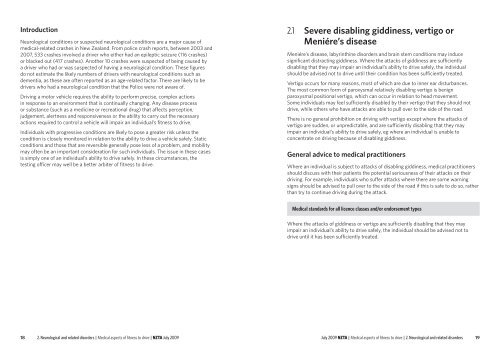Medical aspects of fitness to drive a guide for medical practitioners
Medical aspects of fitness to drive a guide for medical practitioners
Medical aspects of fitness to drive a guide for medical practitioners
You also want an ePaper? Increase the reach of your titles
YUMPU automatically turns print PDFs into web optimized ePapers that Google loves.
Introduction<br />
Neurological conditions or suspected neurological conditions are a major cause <strong>of</strong><br />
<strong>medical</strong>‐related crashes in New Zealand. From police crash reports, between 2003 and<br />
2007, 533 crashes involved a <strong>drive</strong>r who either had an epileptic seizure (116 crashes)<br />
or blacked out (417 crashes). Another 10 crashes were suspected <strong>of</strong> being caused by<br />
a <strong>drive</strong>r who had or was suspected <strong>of</strong> having a neurological condition. These figures<br />
do not estimate the likely numbers <strong>of</strong> <strong>drive</strong>rs with neurological conditions such as<br />
dementia, as these are <strong>of</strong>ten reported as an age‐related fac<strong>to</strong>r. There are likely <strong>to</strong> be<br />
<strong>drive</strong>rs who had a neurological condition that the Police were not aware <strong>of</strong>.<br />
Driving a mo<strong>to</strong>r vehicle requires the ability <strong>to</strong> per<strong>for</strong>m precise, complex actions<br />
in response <strong>to</strong> an environment that is continually changing. Any disease process<br />
or substance (such as a medicine or recreational drug) that affects perception,<br />
judgement, alertness and responsiveness or the ability <strong>to</strong> carry out the necessary<br />
actions required <strong>to</strong> control a vehicle will impair an individual’s <strong>fitness</strong> <strong>to</strong> <strong>drive</strong>.<br />
Individuals with progressive conditions are likely <strong>to</strong> pose a greater risk unless the<br />
condition is closely moni<strong>to</strong>red in relation <strong>to</strong> the ability <strong>to</strong> <strong>drive</strong> a vehicle safely. Static<br />
conditions and those that are reversible generally pose less <strong>of</strong> a problem, and mobility<br />
may <strong>of</strong>ten be an important consideration <strong>for</strong> such individuals. The issue in these cases<br />
is simply one <strong>of</strong> an individual’s ability <strong>to</strong> <strong>drive</strong> safely. In these circumstances, the<br />
testing <strong>of</strong>ficer may well be a better arbiter <strong>of</strong> <strong>fitness</strong> <strong>to</strong> <strong>drive</strong>.<br />
2.1<br />
Severe disabling giddiness, vertigo or<br />
Meniére’s disease<br />
Meniére’s disease, labyrinthine disorders and brain stem conditions may induce<br />
significant distracting giddiness. Where the attacks <strong>of</strong> giddiness are sufficiently<br />
disabling that they may impair an individual’s ability <strong>to</strong> <strong>drive</strong> safely, the individual<br />
should be advised not <strong>to</strong> <strong>drive</strong> until their condition has been sufficiently treated.<br />
Vertigo occurs <strong>for</strong> many reasons, most <strong>of</strong> which are due <strong>to</strong> inner ear disturbances.<br />
The most common <strong>for</strong>m <strong>of</strong> paroxysmal relatively disabling vertigo is benign<br />
paroxysmal positional vertigo, which can occur in relation <strong>to</strong> head movement.<br />
Some individuals may feel sufficiently disabled by their vertigo that they should not<br />
<strong>drive</strong>, while others who have attacks are able <strong>to</strong> pull over <strong>to</strong> the side <strong>of</strong> the road.<br />
There is no general prohibition on driving with vertigo except where the attacks <strong>of</strong><br />
vertigo are sudden, or unpredictable, and are sufficiently disabling that they may<br />
impair an individual’s ability <strong>to</strong> <strong>drive</strong> safely, eg where an individual is unable <strong>to</strong><br />
concentrate on driving because <strong>of</strong> disabling giddiness.<br />
General advice <strong>to</strong> <strong>medical</strong> <strong>practitioners</strong><br />
Where an individual is subject <strong>to</strong> attacks <strong>of</strong> disabling giddiness, <strong>medical</strong> <strong>practitioners</strong><br />
should discuss with their patients the potential seriousness <strong>of</strong> their attacks on their<br />
driving. For example, individuals who suffer attacks where there are some warning<br />
signs should be advised <strong>to</strong> pull over <strong>to</strong> the side <strong>of</strong> the road if this is safe <strong>to</strong> do so, rather<br />
than try <strong>to</strong> continue driving during the attack.<br />
<strong>Medical</strong> standards <strong>for</strong> all licence classes and/or endorsement types<br />
Where the attacks <strong>of</strong> giddiness or vertigo are sufficiently disabling that they may<br />
impair an individual’s ability <strong>to</strong> <strong>drive</strong> safely, the individual should be advised not <strong>to</strong><br />
<strong>drive</strong> until it has been sufficiently treated.<br />
18 2. Neurological and related disorders | <strong>Medical</strong> <strong>aspects</strong> <strong>of</strong> <strong>fitness</strong> <strong>to</strong> <strong>drive</strong> | NZTA July 2009<br />
July 2009 NZTA | <strong>Medical</strong> <strong>aspects</strong> <strong>of</strong> <strong>fitness</strong> <strong>to</strong> <strong>drive</strong> | 2. Neurological and related disorders 19
















